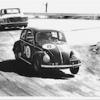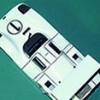I feel some of you blokes need to go to the haberdashery and buy yourself a dressmakers tape. Very handy for a small outlay. You can tape the diameter of the tyre and get true changes and or info.
Old 50s cars for instance used for instance a 5 25x16 on a Vanguard sedan and 600 16 on the utes. The wider tyre was also bigger in diameter. A good inch in height. Often compensated by a shorter diff ratio,
Modern cars are a bigger conunderum. You have to look at the width, the aspect ratio and the load rating. Yet alone the speed rating.
For instance a 195x50x15 tyre generally has a similar roll out to a 195x45x16. And generally the same load rating. Generally [and not always] the 45 aspect tyre has a higher speed rating.
Though different brands still will roll out slightly different too.
AWD/ 4WD cars especially with constant 4wd will never tolerate different diameters. If nothing else it will kill the centre diff and generally the transfer case and gearbox too. With those vehicles be very carefull too. A highway pattern tyre is generally slightly smaller than an A/T tyre which is smaller than a mudder! Really the best [and safest] is the same brand and construction all way around.
THOUGH, some hi performance AWD cars use different tyres one end to the other. A tyre manuafcturer and the car manufacturer have done some very detail work to get [as above] a 35 aspect to marry up exactly with a 40 aspect. Or similar. And on occasion can cause grief with the relacements that are not quite the same size unless you use the OEM tyre,,,, and after a few years OEM do not make the tyres anymore. Ooops. Happens way too aften on very expensive low volume cars and older hi volume cars. And the spare is probably about 3" wide,, but the same dia or very close. A sore point I know with many inc myself.
Ofcourse many [most] 2wd sporties use different size and sometimes aspect front to rear. Though again usually they are similar in dia. Whereas hotrodders just want the 'look' and have a dogs breakfast of sizing. Works ok usually though the spare can be a drama. With passenger on full size vehicles most tyres roll out at about 80". Go measure them!





















